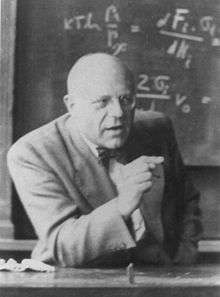Ivan Stranski


Ivan Nikolov Stranski (Bulgarian: Иван Николов Странски; German: Iwan Nicolá Stranski; 2 January 1897 – 1979) was a Bulgarian physical chemist.
The founder of the Bulgarian school of physical chemistry, Stranski is considered the father of crystal growth research.[1][2] Stranski headed the departments of physical chemistry at Sofia University and the Technical University of Berlin, of which he was also rector. The Stranski-Krastanov growth and the Kossel-Stranski model have been named after Ivan Stranski.
Biography
Ivan Stranski was born in Sofia, the capital of the Principality of Bulgaria, as the third child of Nikola Stranski, pharmacist to the royal court, and his wife Maria Krohn,[2] a Baltic German.[3] Ever since his childhood he suffered from bone tuberculosis, an incurable disease at the time. Stranski finished the First Sofia High School for Boys. Seeking ways to fight the illness, Stranski decided to study medicine, though he returned to Bulgaria disappointed after a year of studies in Vienna. He graduated from Sofia University in 1922, majoring in chemistry, and acquired a doctor's degree in Berlin under Paul Günther with a dissertation on X-ray spectroscopy.[3] In 1925, Stranski joined Sofia University's newly established Department of Physical Chemistry of the Faculty of Physics and Mathematics as a reader, becoming the first reader of physical chemistry in the country. By 1929, he was promoted to associate professor and by 1937 he was a regular professor at Sofia University. Stranski attracted prominent scientists such as Rostislav Kaishev and Lyubomir Krastanov to the department.[4]
In 1930, Ivan Stranski received a Rockefeller scholarship and along with Kaishev was invited to the Technical University of Berlin, where he collaborated with prominent physical chemist Max Volmer.[3] The 1930s saw the publishing of several important articles which Stranski co-authored with Kaishev and Krastanov, such as the 1939 discovery of Stranski-Krastanov growth. In 1935-36 he was head of department at the Ural Institute of Physics and Mechanics in Sverdlovsk in the Soviet Union. In 1941, Stranski was invited by Walther Kossel to conduct research in Breslau. He put forth his kinetic theory of crystal growth, which became known as the Kossel-Stranski model – Kossel independently proposed the same model.[3]
With the advance of the Red Army, Stranski returned to Berlin to work at the Kaiser Wilhelm Institute for Physical Chemistry and Electrochemistry. As Nazi Germany surrendered, Volmer was taken by force to the Soviet Union and Stranski took his place as the director of studies at the Technical University of Berlin's Department of Physical Chemistry. Despite the heavy damage caused by Allied bombing, not without Stranski's assistance the Technical University was among the few that opened for the 1945 academic year.[4] In 1948–1949, Stranski was the dean of the Faculty of General and Engineering Sciences. In 1951–1953, Stranski was rector of the university;[5] he also held the position of vice rector. In 1953, he became deputy director of the Fritz Haber Institute. Until 1963, Stranski taught at the Free University of Berlin.[3]
After the Bulgarian coup d'état of 1944 and the installment of a communist government, Stranski was accused of links to the preceding pro-fascist régime and removed from the department that he established. It was not until the 1960s that he was re-accepted as a foreign member of the Bulgarian Academy of Sciences and he would only return to Bulgaria from West Berlin in 1967. He died in Sofia in 1979, but was buried in Berlin.
Ivan Stranski was a member of the Göttingen Academy of Sciences (1939), Bavarian Academy of Sciences and Humanities (1959), New York Academy of Sciences, the German Academy of Sciences Leopoldina and the Swedish Academy of Sciences.[4] Two modern institutes bear his name: the Stranski Laboratory for Physical und Theoretical Chemistry of the Technical University of Berlin (Iwan N.-Stranski-Institut from 1967 to 2001), and the I. N.-Stranski-Institut of Metallurgy in Oberhausen.[3]
References
- ↑ Sretenova, Nikolina. "Ivan N. Stranski: An Exciting Journey to the Academic Top". Union of Scientists in Bulgaria. Retrieved 2009-08-06.
- 1 2 "Iwan Nikolà STRANSKI (1897 – Sofia – 1979)" (in German). History and Foundations of Quantum Physics. Retrieved 2009-08-06.
- 1 2 3 4 5 6 "The shoulders on which we stand: Iwan N. Stranski (1897-1979)". Technische Universität Berlin. Retrieved 2009-08-06.
* Knobloch, Eberhard (2004). Technische Universität Berlin, ed. "The shoulders on which we stand": Wegbereiter der Wissenschaft : 125 Jahre Technische Universität Berlin (in German). Springer. pp. 166–168. ISBN 978-3-540-20557-9. - 1 2 3 Пенчев, Бойко (2008). "Проф . Иван Странски (1897—1979)". 120 години Софийски университет "Св. Климент Охридски": Традицията да бъдеш първи (PDF) (in Bulgarian). Университетско издателство „Св. Климент Охридски“. pp. 80–81. Retrieved 2009-08-06.
- ↑ "Rektoren und Präsidenten seit 1946" (in German). Technische Universität Berlin. Retrieved 2009-08-06.